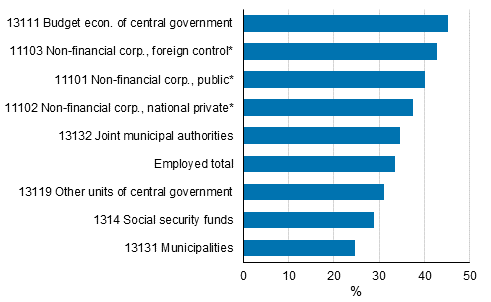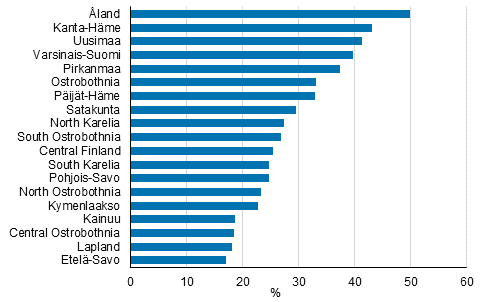Published: 27 September 2017
Nearly one-half of central government employees worked outside their municipality of residence in 2015
According to Statistics Finland’s employment statistics, around every third employed person worked outside their municipality of residence in 2015. Commuting was more common in central government than in the non-financial corporations sector. The average distance to work was also longer for central government employees than for employees in the non-financial corporations sector. Commuting was most general in Åland and Kanta-Häme.
Share of those working outside their municipality of residence among employed persons by sector in 2015, %

*excl. housing corporations
In the sector-specific examination the focus is on the non-financial corporations sector (excl. housing corporations) and central and local government sectors, on which data are available on the most detailed level of the classification (Classification of Sectors 2012).
Thirty-nine per cent of those working in non-financial corporations worked outside their municipality of residence. Forty-one per cent of those working in central government commuted and 28 per cent of those working in local government (Appendix table 1).
The central government sector is divided into on-budget entities and other central government units. On-budget entities include ministries and other agencies and institutions operating in various central government administrative branches. Other central government units are such as universities and limited companies controlled by central government that operate as non-market producers.
Forty-five per cent of employees in on-budget entities worked outside their municipality of residence. Within general government, commuting was least common among municipal employees of whom only every fourth commuted.
Among those working in non-financial corporations, employees of foreign-owned enterprises commuted most and those working in domestic enterprises least.
Central government employees’ average distance to work nearly 19 kilometres
The average distance to work 1) was 14.1 kilometres in 2015. The average distance to work was 15.7 kilometres for those working in non-financial corporations (excl. housing corporations).
The average distance to work for central government employees was nearly double compared to local government employees. The average distance to work for central government employees was 18.8 kilometres and for local government employees 11.3 kilometres.
The average distances were longest for those working in on-budget entities (21.6 km) and in foreign-owned non-financial corporations (16.5 km). The distances were shortest for local government sector employees (10.3 km).
Working in one's municipality of residence was most common in the region of Etelä-Savo.
In Mainland Finland, the share of commuters was biggest in Kanta-Häme, where 43 per cent of employed persons living in the region worked outside their municipality of residence. In Uusimaa the share of commuters was 41 per cent. The share of those working outside their municipality of residence remained under 20 per cent in the regions of Etelä-Savo, Lapland, Central Ostrobothnia and Kainuu.
Share of those working outside their municipality of residence among employed persons by region in 2015, %

Examined by region, the average distance to work was longest for those living in Kanta-Häme, 18.8 kilometres (Appendix table 2). The shortest average distance to work in Mainland Finland was in Ostrobothnia (10.6 km).
1) The distance to work describes the distance between home and workplace measured as the crow flies. When calculating the average for distance to work, account was not taken of distances of over 200 kilometres.
Source: Employment Statistics, Statistics Finland
Inquiries: Netta Hiitola 029 551 3552, info@stat.fi
Director in charge: Jari Tarkoma
Publication in pdf-format (223.2 kB)
- Tables
-
Tables in databases
Pick the data you need into tables, view the data as graphs, or download the data for your use.
Appendix tables
Updated 27.9.2017
Official Statistics of Finland (OSF):
Employment [e-publication].
ISSN=2323-6825. Background information on unemployed persons 2015. Helsinki: Statistics Finland [referred: 16.12.2025].
Access method: http://stat.fi/til/tyokay/2015/03/tyokay_2015_03_2017-09-27_tie_001_en.html

